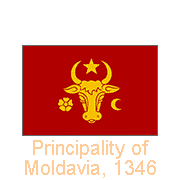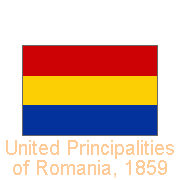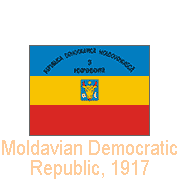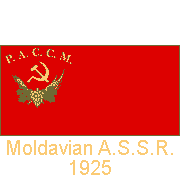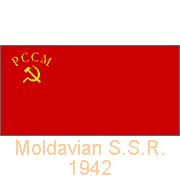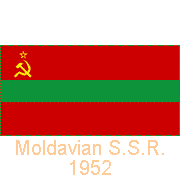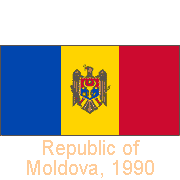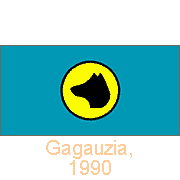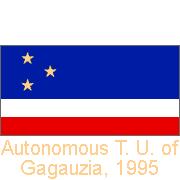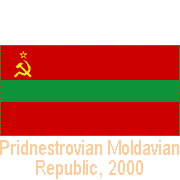Flags from Moldova
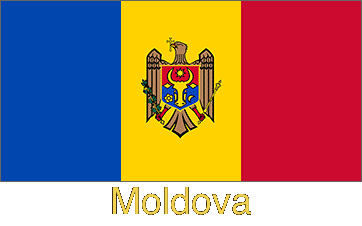
A Flag history of Moldova
Moldavia emerged as a distinct and independent principality in the mid-14th century. It adopted as its emblem was the head of a bison, or, possibly an aurochs, a now-extinct type of large wild cattle that inhabited Europe, Asia, and North Africa, the ancestor of domestic cattle. It survived in the remoter regions of eastern Europe until the early 17th century. There is a story that Dragoș, a voivode (a local ruler) from Maramureș (in northern Romania), hunted for a star-marked bull aurochs with his female hound, Molda. The aurochs killed the dog on the shore of a river, which was then named after the dog and “Moldova” or “Moldavia” became the country’s name. The bison’s head became its coat of arms, displayed on a red military flag with a star between its horns and flanked by a rose and crescent.
you may then send it as a postcard if you wish.
Bessarabia (the area roughly corresponding with present-day Moldova) had been under Ottoman and Russian rule. However, it became free in 1856 after the Crimean War, and in 1859 the Principality of Wallachia (now part of Romania) and Moldavia united as the United Principalities of Romania. Different coats of arms and flags were proposed but, although these were never standardised, three colours that had already been proposed in 1848 were used; these represented the three parts of Romania: Red - Moldavia; Blue - Oltenia (east Wallachia, Great Wallachia); Yellow - Muntenia (west Wallachia, Lesser Wallachia). The southern part of Bessarabia had again become under Russian rule in 1878. After the Russian revolution of 1917, the Bessarabian Parliament, Sfatul Țării (National Council), proclaimed the Moldavian Democratic Republic within a federal Russian state that year. On 6 February 1918, it declared the independence of Bessarabia. Its flag displayed the Romanian colours blue-yellow-red with the coat of arms on the central stripe and the words “Moldavian Democratic and Independent Republic” in the upper bar. On 9 April 1918, the National Council voted for a union with Romania, and Bessarabia became part of a greater Romania that included the former Hungarian territory of Transylvania. The colours of the Romanian flag remained blue-yellow-red; the vertical version was adopted in 1866, and this has remained the Romanian flag ever since.
On 7 March 1924, the “Moldavian Autonomous Oblast” (Province or Area) was created within the Ukrainian Soviet Socialist Republic (SSR), east of the Dniester river. On 12 October 1924, it was renamed the “Moldavian Autonomous Soviet Socialist Republic”. It obtained a red flag with, in yellow, a hammer and sickle and the Moldovan (Romanian) abbreviation of the republic’s name. It read "RASSM" (Republica Autonomă Sovietică Socialistă Moldovenească), in Cyrillic script, that had been adopted in December 1924. The Soviet pretence was that “Moldavian” is different from “Romanian”, written with Latin script. It also featured agricultural produce from the region: grain, grapes and corn. In 1932 there was a trend in the Soviet Union to move all non-Slavic languages to Latin script. In 1937 the Moldovan ASSR adopted a new flag, featuring on a red field, under a hammer and sickle emblem, in large letters the abbreviation of “Ukrainian Soviet Socialist Republic” and in smaller letters “Moldovan ASSR” in both Ukrainian and Moldovan. The latter was in Latin script, but a year later, in 1938, the Cyrillic script was again declared official for the Moldavian language. The flag of the Moldovan ASSR changed accordingly: now all in Cyrillic script. In 1940 Soviet troops crossed the Dniester and occupied Bessarabia, part of Romania, between the two World Wars. On 2 August that year, the Soviet Union established the Moldavian Soviet Socialist Republic (Moldavian SSR), consisting of six counties of Bessarabia, joined to the westernmost part of what had been the Moldovan ASSR - now the breakaway region of Transnistria. A year later, a new flag was introduced: red with, in yellow, the hammer and sickle emblem and in Cyrillic lettering, “RSSM”, the abbreviation in Moldovan, of Moldavian SSR. In 1952 the Moldavian SSR, like other Soviet Republics, had to adopt a flag similar to the Soviet Union flag: It was red with, in yellow, the hammer and sickle emblem and a yellow-bordered red star, but with a green bar in the middle, ¼ the width of the flag.
On 27 April 1990, a new flag was approved. On 12 May 1990, it was officially adopted: it readopted a vertical blue-yellow-red tricolour, like Romania, but with proportions 2:1 and the coat of arms in the centre of the flag: an eagle with a cross in its beak and a sceptre and olive branch in its claws, protected by a shield bearing the traditional arms of Moldavia: an aurochs’ head with a star between its horns. It also contains two lozenges (the ears), a five-petaled rose and a crescent moon. On 23 May 1991, the Moldavian Parliament changed the republic’s name to the Republic of Moldova, and on 27 August that year, Moldova seceded from the Soviet Union and became a sovereign, independent state.
The Gagauzians, a Christian people speaking a Turkic language, who settled in Bessarabia after they fled Ottoman rule in what is now Bulgaria, had an unofficial flag: a sky blue field (often associated with Turkic peoples and also used by Crimean Tatars and Uyghurs) and, on a yellow disk, the profile of a wolf, symbolic of the mythical origin of the Turkic peoples from whom the Gagauzians are descended. They worried that Moldova might unite with Romania and their future. They preferred to remain with the USSR, but when that was abolished, they declared independence on 19 August 1991. It was not granted, but on 23 December 1994, Moldova’s Parliament awarded Gagauzia the status of “national-territorial autonomous unit” - Gagauz Yeri, four small territories in the south of the country with a predominant Gagauz population. On 31 October 1995, a flag was adopted of blue-white-red, with three yellow stars (representing the three largest parts of Gagauzia) in the upper blue stripe, ⅗ of the flag’s height.
On 2 September 1990, the narrow strip of Moldova to the east of the Dniester river seceded after the breakup of the USSR and declared its independence as the Pridnestrovian Moldavian Republic (PMR); they also had feared Moldova would unite with Romania. After a war between the separatists and the Moldovan Army, Russian troops intervened, and a ceasefire agreement was signed on 21 July 1992. It is now a “frozen conflict”, and the “Pridnestrovian Moldavian Republic” is only recognised by similar unrecognised breakaway states: Abkhazia, Nagorno-Karabakh and South Ossetia. They retain the old flag of the Moldavian Soviet Socialist Republic: Officially adopted on 25 July 2000, it has three horizontal stripes, in proportions of 3:2:3, of red, green and red with a yellow hammer and sickle and a yellow-bordered red star in the upper hoist.


